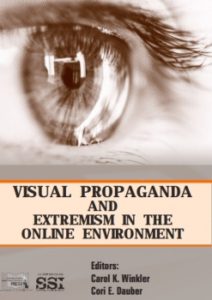Issue 22, spring 2016
https://doi.org/10.70090/BRRC16VP
The media landscape has been transformed by new Internet platforms over the last ten years. Extremist propaganda has increased considerably alongside the rise of this contemporary visual environment. The availability of online video has impacted conflicts across the Middle East in particular: disintegration of nation–states in the region has amplified the perspectives of Islamic terrorist groups able to rapidly disseminate their content through support networks. The internationalization of the Syrian war provides the clearest contemporary example, in which the governing powers continually face new challenges to curb and counteract messages from such radical movements. In light of this, a recent publication examines the use of Internet technology and communication platforms for the distribution of visual—mostly video—content on user-friendly websites. This research is important for the media scholar and the general reader alike because ever-expanding extremist groups continue to impact the daily lives of ordinary citizens.
The edited volume, Visual Propaganda and Extremism in the Online Environment, is published by the Strategic Studies Institute (SSI) and U.S. Army War College (USAWC). It is available free of charge to download on both websites or in print from an online self-publisher. The content emerges from an academic conference at Georgia State University in March 2012. The publication is divided into three main sections, each containing a series of articles with varying authorship that survey existing arguments within the section’s topic.
In the first section, “Perspectives on the Re-Circulation of Online Visual Images,” there are two contributions that broadly address the replication and dissemination of images in online environments. The first article by Anne Stenersen uses video evidence from 18 court cases as a sample to classify genres of videos produced and distributed by extremist groups (mostly between 2001 and 2009). Her research offers useful insight into the development of jihadist videos, which occurs within a subculture of online communities in shifting conflict zones. By reposting in these online communities, support networks project videos into wider cultural spheres. In doing so they also expose the hackneyed nature of the simplistic but effective narratives employed in the original videos. The second article by one of the co-authors is less accomplished. It awkwardly lists a series of unsubstantiated visual reading theories in relation to iconic 20th century photographic images. These images seem to bear little visual relevance to the video works produced by new militant groups in the 21st century. For instance, the culturally contingent impact of Doretha Lange’s Migrant Mother image in 1936 lacks an obvious parallel. In its dubious employment of reductive academic theories on image communication, this qualitative analysis raises concerns about the publication’s bias.
Section two, “Perspectives on Message Strategies of Online Extremists,” consists of two articles. The first piece departs topically with an analysis of the white racist propagation of hate crimes in American public forums. The second article returns to the Middle East to examine video narratives of al-Qaeda and its affiliated movements. The author’s research reveals significant expansion in the scope of these visual productions that includes a wide range of visual references outside the theater of war. This more sophisticated communication approach uses, for instance, popular Hollywood films and footage from other conflicts to create narratives of loosely interrelated stories. The added historical content facilitates subsequent adaptation of the original videos; it also adds layers to the productions by disrupting time relationships. The author refers to supporters who propagate these visual productions as “jihobbyists.” They play a crucial role in developing new online audiences who, in turn, continue the viral spread of extremist videos across the Internet. As the authors state, this process challenges traditional broadcast media methods to catch up with the open and fluid culture of the World Wide Web.
The third section, “Perspectives on Audiences and Images in Online Environments,” predictably shifts focus from production to consumption. The overlap of these two functions gives rise to a new community of individuals, termed “prosumers.” Unfortunately, in focusing predominately on Middle Eastern video productions, the authors neglect to examine media’s relationship to its audience in any depth. This section consists of four original articles and a chapter of concluding remarks. The piece by Shawn Powers and Matt Armstrong contemplates the potential audience for such radical visual content and shows how contemporary Internet culture enables unrivaled freedom of expression with unfettered access to publication. Even so, the authors rightly point out that this chaotic space has been assigned boundaries that grant it a degree of stability. The third contribution in this section is one of the most impressive ones in the entire publication. It looks at the background metadata content of image productions: In the vast image domain of accessible production and distribution, how do we find some videos and not see others? Understanding the constitution of visibility and obscurity is crucial to the contemporary image paradigm. In his article, Saied Balkesim delves into the interface of human (semantic) features and hidden computer information by deconstructing the image from an information perspective. This approach brilliantly explores the pixel to understand how data functions in effective image-retrieval algorithms. We are reminded of the significant power that unfriendly technology wields in making the World Wide Web and the Dark Web function.
This publication is a welcome addition to the existing discourse on visual content; the importance of such conversations cannot be understated because of the political influence that visual media exercises in our increasingly interconnected world. However, regrettable discontinuities in theme, style, and quality cause the collection of articles produced here to disappoint. As delayed publications substantiated by earlier conferences risk, the scope and intellectual coherence of this publication are insufficient: ideas repeat and overlap without advancing. Furthermore, the publication is deficient in an overall critical perspective and leaves significant questions untreated. For instance, the authored chapters completely ignore work in relevant academic fields—such as visual culture, media theory, and phenomenology—that offer accounts for biological and psychological relationships to imagery. Moreover, the publication looks for a solution to dangerous and extremist Islamic groups without any acknowledgment of U.S. militarism’s role in inciting violence against the West. Despite exhaustively addressing countermeasures to violent video content, the publication fails to query the potential for legitimate causes of the rise of jihadism in Muslim communities. Lastly, the omission of ISIS from the research scope severely diminishes the publication’s quality and usefulness, especially in relating its content to its desired audience.
Notwithstanding the notable exceptions mentioned earlier, the publication misses the opportunity to furnish a relevant and accessible body of knowledge to stimulate further research; this outcome forgoes the publication’s overall potential to meaningfully expand understanding and insight for future generations. The publication appears as a self-published book and free PDF download, although it emerges with inflection from the U.S. military. The research content would have benefitted from a more rigorous discursive process. More thorough conversation would have added nuance to the cultural context and helped to mitigate the publication’s Western-centric objective: controlling challenges to U.S. hegemony. Although the World Wide Web was initially developed with military ambitions, the contemporary Internet on which the research is based exemplifies more horizontal power relations well.
Instead of seeking ways to suppress extremism, nation–states need to focus on illuminating sources of conflict as a means to dislodge visual propaganda’s direct power in the physical world. The ease of producing and disseminating video content facilitates constant reposting on free websites. Therefore, the pointed counter-narrative strategies that the publication suggests are unsound. The publication’s reductive argument fails to convey the complex nature of visual media and the cultural contingencies at the heart of this communication process.
Ronnie Close is an Assistant Professor in the Department of Journalism and Mass Communication at the American University in Cairo.
 Arab Media & Society The Arab Media Hub
Arab Media & Society The Arab Media Hub






